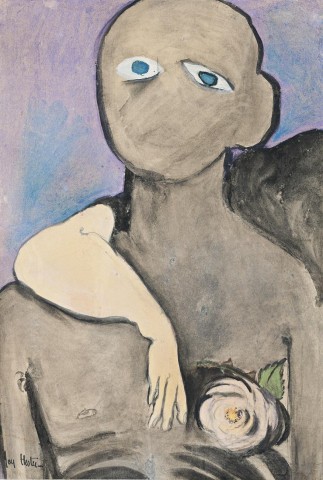LOVERS WITH ROSE, c.1947
JOY HESTER
watercolour, pastel, brush and Chinese ink on paper on card
54.0 x 36.5 cm
signed with estate stamp lower left
Tolarno Galleries, Melbourne (label attached verso)
Private collection, Melbourne, acquired from the above in 1976
Joy Hester, Tolarno Galleries, Melbourne, 6 – 25 October 1976, cat. 91 (as ‘Lovers, c.1950’)
Although Joy Hester’s art was neither strictly diaristic or autobiographical, the story of her life is so complex and familiar that connections are inevitably made between what we know (or imagine we know) of her experiences and feelings, and the images she created. This is especially so of images which focus, in Hester’s characteristically direct and psychologically charged style, on the depiction of human relationships and the expression of emotion. The theme of love is persistent in much of her work, but especially from 1947, a year which marked the beginning of a particularly turbulent period in Hester’s life. Diagnosed with Hodgkin’s Disease, her marriage to Albert Tucker ended and two years later her son, Sweeney, was formally adopted by John and Sunday Reed. It was a new relationship with the poet/painter, Gray Smith, also begun in 1947, which would sustain her emotionally and artistically until the end of her life, that provided the backdrop to the well-known images of lovers produced during the late 1940s and mid-1950s.
The head and torso of a naked male figure fills the sheet in Lovers with Rose, c.1947, his striking blue eyes staring directly out at the viewer. Slightly askew, they are the only facial feature depicted, compelling and with an intensity that recalls the piercing eyes in contemporary paintings by Sidney Nolan – Hester’s friend and one of the avant-garde artists who gathered around John and Sunday Reed at Heide. His lover is out of view, but her long hair trails over his left shoulder, and opposite, her arm hangs languidly across his chest, delicate fingers seemingly pointing to the pale pink rose. Itself a symbol of love, the rose in this work is said to relate to a floral motif that Hester later designed for Sunday Reed, which was etched into the glass panels either side of the front door at Heide. In the renovation of the Reed’s farmhouse undertaken in the early 1950s, the rose also featured in the decorative wallpaper Sunday chose for the master bedroom and in Nolan’s painting¸ Rosa Mutabilis, 1945 (Heide Museum of Modern Art) – a memento of her love affair with the young artist – which she displayed there,1 as well as various living specimens that grew in the garden.
Unlike her male peers, who produced their major works in oil paint, Hester worked predominantly in ink and watercolour, and the lower status of these media in the fine art hierarchy is one of the reasons why her work was so little known and appreciated during her lifetime. Although Hester’s work was unrepresented in any public collection at the time of her premature death in 1960, it is now widely collected, with major holdings in the National Gallery of Australia and Heide Museum of Modern Art. Hester’s distinctive way of depicting the human figure, combined with the immediacy of her chosen medium, results in a remarkable sense of intimacy that seems to transcend the inevitable distance between the artist, their artwork and the viewer. For Hester, art was a means of self-expression and communication – ‘[she] drew the way other people speak: it was as natural and as simple as that’.2
1. See Harding, L. & Morgan, K., Modern Love: The Lives of John & Sunday Reed, The Miegunyah Press, Melbourne, 2015, pp. 241 – 242
2. Barrett Reid quoted in Gellatly, K., Leave no space for yearning: The Art of Joy Hester, exhibition catalogue, Heide Museum of Modern Art, Victoria, 2001, p. 14
KIRSTY GRANT
